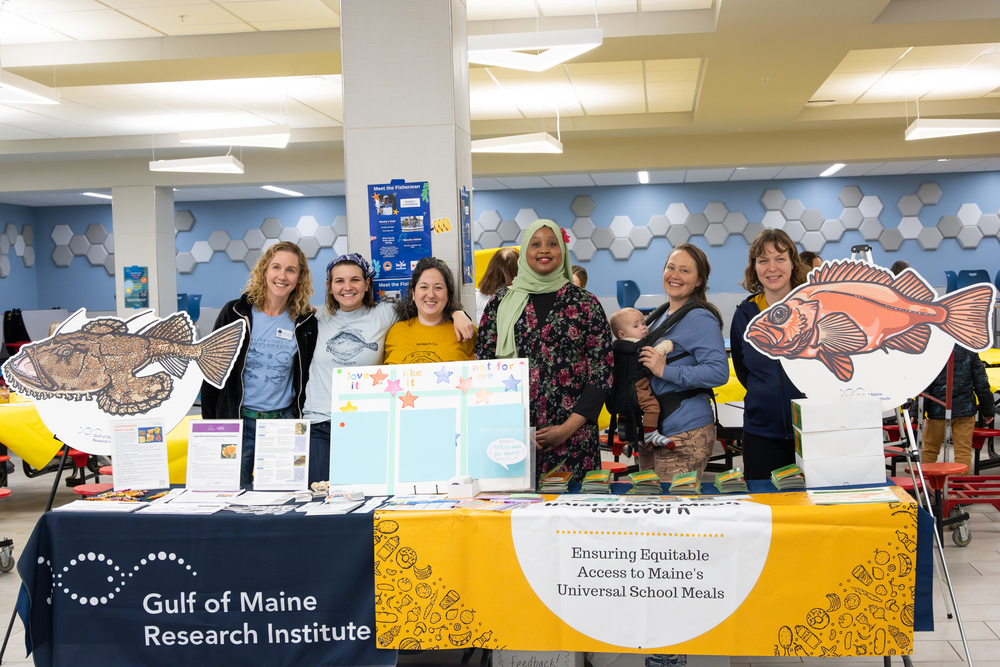Published September 25, 2025, Gulf of Maine Research Institute.
Our seafood team is working with partners across New England to establish a comprehensive sea to school program focused on the Gulf of Maine region. Read more about this collaborative effort here.
School cafeterias are powerful entry points for shaping lifelong healthy eating habits in students, and seafood represents one of the most nutritious foods you can put on a cafeteria tray.
Responsibly harvested seafood is a superfood, rich in nutrients like vitamins A and D and omega-3 fatty acids — all of which are important for the growth and development of healthy kids.
Many of the schools we work with through our Sea to School program have high percentages of students that receive free and reduced lunch, and on average, students get about one-third of their daily caloric intake from public school lunch programs, so serving up seafood is a great opportunity to meet students’ nutritional needs.
Seafood is also deeply tied to New England’s heritage. Fishing has long been part of New England’s identity, and K–12 schools represent a critical market for the region’s fishermen and sea farmers. By introducing students to local seafood at a young age, Sea to School helps build both current and future demand for a wide range of Gulf of Maine species, ensuring that students grow into informed consumers who support local food systems.
Yet in Maine and across New England, many schools struggle to connect students with healthy, locally sourced seafood.
Discover how Maine schools are transforming student nutrition and education through a groundbreaking local seafood initiative.
The Early Phases
For many immigrant, refugee, and asylee families, seafood is also a familiar staple, and culturally relevant recipes can create a sense of connection and belonging in the cafeteria. That’s why our program works to support schools with diverse student populations like Westbrook, Portland, and South Portland. During one particular project funded by the Henry P. Kendall Foundation’s New England Food Vision Prize, our team worked closely with local immigrant chefs and food service workers to develop easy-to-make, culturally relevant recipes.
Students responded with overwhelming positivity. Throughout multiple taste test events, where students could try anything from coconut lime Acadian redfish to seven-spice Iraqi fish, an average of 75% of students indicated they loved the new dishes. One student captured the value of this cultural connection, sharing, “This tastes just like the fish my mom makes at home.”
"Finding food that you recognize is a way of establishing belonging."
Khadija Ahmed
Founder and Board President
Food For All Services
Early outcomes also underscored the importance of staff engagement. Trainings for food service teams not only built technical skills — such as working with raw fish filets — but also helped staff understand the broader impact of their work. When food service staff feel ownership of the program, it translates to students who are more likely to choose the seafood option at lunch.
This work also helped influence supply chains. Fish sticks made with local Gulf of Maine haddock, once available only by special order, are now a standard product because of the demand created by participating schools.
The Role of Partnerships
This work would not be possible without strong partnerships. Collaborations with organizations and networks across the region reinforce Sea to School’s goals, provide essential training opportunities, and create momentum for change in school cafeterias.
For example, the Maine Coast Fishermen’s Association’s Fishermen Feeding Mainers (FFM) program gives schools the chance to experiment with local fish at no cost. Once food service staff had the opportunity to try preparing and serving meals made with fish fillets for free from the FFM program, many discovered they were easier to work with than expected — and became more inclined to purchase raw fish in the future.
Similarly, connections with the Halal School Meals Network have helped highlight seafood as a natural fit for meeting the dietary needs of Muslim students, since fish comes out of the water halal. This not only expands menu diversity but also ensures inclusivity for students who follow halal dietary guidelines.
These partnerships amplify the impact of Sea to School, making it easier for schools to overcome barriers and embrace local seafood.
That collaborative spirit is reflected in the experiences of dedicated food service directors across the region, including Mary Emerson the School Nutrition Director in Westbrook, ME, who has seen firsthand how this work reshapes what’s possible in the cafeteria.
Expanding the Work
The initial phases of our Sea to School work demonstrated that local seafood belongs in K–12 schools. Now, with renewed funding support — including from the Henry P. Kendall Foundation and the Partnerships for Local Agriculture & Nutrition Transformation in Schools (PLANTS) Grant program, which is funded by the USDA Food & Service Healthy Meals Incentives Initiative and administered by Chef Ann Foundation — we are broadening our efforts to provide long-term sustainable change through the “three C’s” framework: cafeterias, classrooms, and communities.
We are delivering regional trainings to food service workers that emphasize both the how (technical preparation, recipe flexibility, species diversity) and the why (nutrition, climate benefits, economic impact) of serving local seafood. We’re building a network of practitioners to share resources and troubleshoot challenges. We’re intentionally embedding seafood into farm-to-school programming to ensure it becomes a fixture of school culture, and we’re engaging beyond the classroom and cafeteria with school community members to build awareness and excitement around this work.
Progress is already visible. South Portland features seafood as a regular part of its cycle menu, and Chicopee Public Schools in Massachusetts has reached out to coordinate training for staff for its districts and others in the area, representing an increased interest in schools looking to participate in sea to school programming.
Looking Ahead
Looking forward, we will strengthen our role as a resource for schools interested in Sea to School programming. Interest is growing beyond New England, with organizations in Washington State and California reaching out for guidance.
In the coming years, we envision a future where high-quality, local seafood products and recipes are widely available to schools, and culturally relevant seafood becomes a staple of K–12 meals.
Ultimately, Sea to School is about more than what’s on the tray. By building these community connections now, this program is helping ensure the health of students, our working waterfront, and our ecosystem remains strong into the future.

